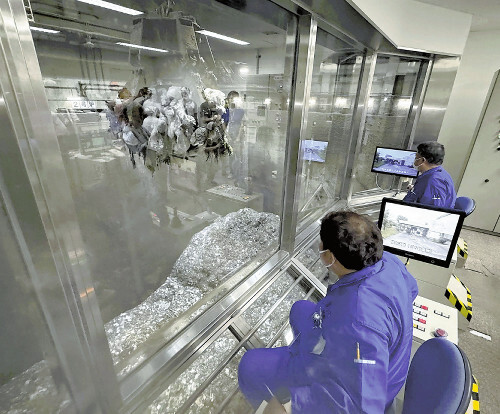
By Will Dunham
WASHINGTON (Reuters) -Scientists have detected some of the oldest signs of life on Earth using a new method that recognizes chemical fingerprints of living organisms in ancient rocks, an approach that also holds promise in the search for life beyond our planet.
The researchers found evidence of microbial life in rocks about 3.3 billion years old from South Africa, when Earth was roughly a quarter its current age. They also found molecular traces left by microbes that engaged in oxygen-producing photosynthesis - conversion of sunlight into energy - in rocks about 2.5 billion years old from South Africa.
The scientists developed an approach, harnessing machine learning, to distinguish in ancient rocks between organic molecules with a biological origin - like from microbes, plants and animals - and organic molecules with a nonliving origin at greater than 90% accuracy. The method was designed to discern chemical patterns unique to biology.
"The remarkable finding is that we can tease out whispers of ancient life from highly degraded molecules," said Robert Hazen, a mineralogist and astrobiologist at the Carnegie Institution for Science in Washington and co-lead author of the study published this week in the journal Proceedings of the National Academy of Sciences. "This is a paradigm shift in the way we look for ancient life."
"We collect and concentrate carbon-rich molecules, analyze them in a way that identifies thousands of tiny molecular fragments, and then look at their distributions with machine learning. The human eye just sees hundreds or thousands of little 'peaks' of different molecules, but the machine learning method teases out subtle patterns that distinguish molecules that were once alive from those that were not," Hazen said.
Scientists hunting for evidence of Earth's earliest life have relied primarily on finding fossil organisms. Earth formed approximately 4.5 billion years ago. Its first living organisms may have been microbes that arose perhaps hundreds of millions of years later at marine hydrothermal vents or terrestrial hot springs.
The oldest definitive fossils of living organisms are mound-like microbial deposits called stromatolites about 3.5 billion years old in Australia and microbial mat structures of similar age in South Africa. But such fossils are exceptionally scarce.
Another way to find evidence of early life is to look for traces of biomolecules - chemicals related to living organisms - in ancient rocks. The new approach takes that path.
For instance, the researchers discovered organic molecular evidence that oxygen-producing photosynthesis, which over time oxygenated the planet's atmosphere and enabled the evolution of complex aerobic life, was underway by marine bacteria more than 800 million years earlier than previously documented by this type of data.
"It was well known from other evidence that Earth became oxygenated by 2.5 billion years ago and maybe even a little earlier. So we have provided the first convincing fossil organic molecular evidence, with the prospect of pushing the record even farther back," Hazen said.
All of the ancient biomolecules, like sugars or lipids such as fats, are gone and fragmented into little pieces with only a handful of carbon atoms. Yet the distribution of those fragments is remarkably different for suites of organic molecules in life versus nonlife.
"First, we've roughly doubled the age at which we can identify signs of life using organic molecules, from 1.6 billion to 3.3 billion years," said study co-lead author Anirudh Prabhu, a Carnegie Institution for Science mineralogist, astrobiologist and data scientist.
"Second, this biosignature technique can distinguish not just life from nonlife but different kinds of life, such as photosynthetic organisms. Third, our paper shows how machine learning can identify the fingerprints of life in ancient rocks, even when all original biomolecules are degraded," Prabhu said.
NASA rovers have collected rock samples on Mars in a quest to learn whether Earth's planetary neighbor ever harbored life. Other destinations in our solar system also hold potential in the search for life, including Saturn's moons Enceladus and Titan and Jupiter's moon Europa.
The researchers have received a NASA grant to develop their approach for identifying evidence of life.
"One key application area for our project is astrobiology," Prabhu said.
Hazen said, "We are very excited about the prospects of using this method on samples from Mars, ideally those returned to Earth but possibly on a future rover mission. We are also thinking about ways to sample the organic-rich plumes of Enceladus or the surface of Titan or Europa."
(Reporting by Will Dunham; Editing by Daniel Wallis)
latest_posts
- 1
 ジュニアの16人組「少年忍者」、今月末で活動終了「個人の活動に専念」…コメント全文(スポーツ報知)
ジュニアの16人組「少年忍者」、今月末で活動終了「個人の活動に専念」…コメント全文(スポーツ報知) - 2
 村上争奪戦開始!ポスティング申請発表 イブ前決着へ複数球団が興味 交渉期間来月23日午前7時まで(スポニチアネックス)
村上争奪戦開始!ポスティング申請発表 イブ前決着へ複数球団が興味 交渉期間来月23日午前7時まで(スポニチアネックス) - 3
 「なかなか行けない場所」ツアー人気…清掃工場の操作室・空港の制限区域・銭湯の裏側などに「発見」求め(読売新聞オンライン)
「なかなか行けない場所」ツアー人気…清掃工場の操作室・空港の制限区域・銭湯の裏側などに「発見」求め(読売新聞オンライン) - 4
 Step by step instructions to Protect Your Senior Condo for Ideal Wellbeing and Solace
Step by step instructions to Protect Your Senior Condo for Ideal Wellbeing and Solace - 5
 Tech for Efficiency: Applications and Instruments to Accomplish More
Tech for Efficiency: Applications and Instruments to Accomplish More
 Vote in favor of Your Number one kind of pie
Vote in favor of Your Number one kind of pie Find the Excellence of Old style Expressive dance: Encountering the Effortlessness and Polish of Dance
Find the Excellence of Old style Expressive dance: Encountering the Effortlessness and Polish of Dance Which Breakfast Enraptures Your Taste Buds? Vote
Which Breakfast Enraptures Your Taste Buds? Vote 門脇遥香、引きこもりから大河女優のシンデレラストーリー「ドラマに勇気をもらった」(スポーツ報知)
門脇遥香、引きこもりから大河女優のシンデレラストーリー「ドラマに勇気をもらった」(スポーツ報知) Financial plan Cordial Home Redesigns That Add Worth
Financial plan Cordial Home Redesigns That Add Worth Flights canceled at 40 U.S. airports: Follow live updates as FAA cuts to air traffic take effect amid government shutdown
Flights canceled at 40 U.S. airports: Follow live updates as FAA cuts to air traffic take effect amid government shutdown Vote in favor of Your Number one Cake Type
Vote in favor of Your Number one Cake Type Find the Wonders of the Silk Street: Following the Antiquated Shipping lanes
Find the Wonders of the Silk Street: Following the Antiquated Shipping lanes All that You Really want to Be familiar with Dental Inserts Facilities
All that You Really want to Be familiar with Dental Inserts Facilities













